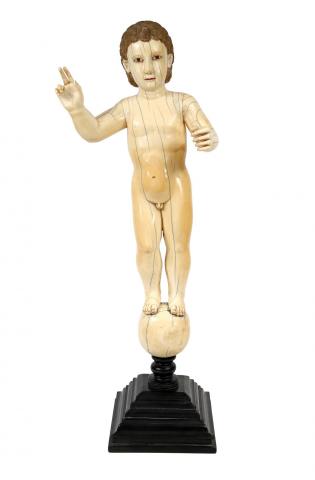Menino Jesus Salvador do Mundo
The Child Jesus Salvator Mundi
Carved and polychrome ivory
Ceylon (present day Sri Lanka), early-17th century
Height: 50.0 cm
Marfim entalhado com policromia
Ceilão (actual Sri Lanka), séc. XVII (inícios)
Altura: 50,0 cm
Superbly carved elephant ivory sculpture with polychrome hair, depicting the Child Jesus Salvator Mundi standing on the orb, the terrestrial globe, in a clear allusion to World Sovereignty. The Child is blessing with His raised right hand while holding a now lost silver or gold cross staff in the left.
This exceptionally large devotional figure features some of the most distinctive characteristics of the Ceylonese imagery produced under Portuguese patronage and which distance it from the later Indian production from Goa; the egg shaped globe under the Child’s feet is carved out of the same ivory tusk as the image that surmounts it and the figure is portrayed with a pierced left hand to fit the precious metal tall cross staff.
The long lasting impact left by the devotional sculptures made in Ceylon for the Portuguese market was described first-hand by Jan Huygen van Linschoten (1563-1611), the author of the famous Itinerario printed in 1596 and later published in English as Discours of Voyages into Ye East & West Indies.
While in Goa, in the service of the Portuguese Archbishop Vicente Fonseca, van Linschoten was gifted a Crucified Christ image by the prelate. Approximately 45 cm in height, this image was described by the author as being produced in an exceptional and diligent fashion, in that its hair, beard and face seemed as natural as those of a real person, while also being so finely carved and with such well-proportioned limbs that could not be found in its European counterparts.
Deriving from a carving tradition that was soon used to Portuguese advantage the commissioning of religious imagery - be it by missionaries entrusted with the indoctrination of new converts or by court officials settled in the Portuguese State of India - encouraged the large scale manufacturing of Catholic imagery in Ceylon. This exceptional production would reach undisputed fame and prestige throughout Asia, becoming the starting point and main dissemination centre of an industry that, once the island was taken by the Dutch in 1658, would be transferred to Goa.
Uma figura em pé do Menino Jesus Salvador do Mundo (Salvator Mundi) delicadamente entalhada em marfim de elefante com policromia (cabelos), sobre o orbe, simbolizando a soberania sobre o mundo inteiro.
Assente no globo terrestre, o Menino faz o sinal da bênção com a mão direita, enquanto agarraria com a esquerda uma vara crucífera de prata ou ouro.
Esta importante escultura devocional em marfim, extraordinária dada a sua dimensão, apresenta as características mais importantes da imaginária cingalesa produzida sob influência portuguesa e que a distinguem da produção goesa posterior: o globo em forma de ovo sob os pés do Menino é esculpido na mesma presa de marfim que o resto da imagem, e a figura é representada com o punho esquerdo vazio, destinado a segurar uma vara crucífera em metal precioso.
O impacto duradouro deixado pelas esculturas devocionais de marfim feitas no Ceilão para os portugueses foi testemunhado em primeira mão por Jan Huygen van Linschoten (1563-1611), o autor do famoso Itinerario publicado em 1596.
Enquanto Linschoten esteve ao serviço do arcebispo luso Vicente Fonseca, em Goa, recebeu o prelado a oferta de uma escultura de marfim do Cristo Crucificado com cerca de quarenta e cinco centímetros de comprimento, que o autor descreve como tendo sido produzido de maneira tão excelente e diligente que o seu cabelo, barba e rosto pareciam tão naturais como se fossem de um ser vivo, e tão finamente entalhado, com membros tão bem proporcionados que não lograria ver peças semelhantes feitas na Europa.
Decorrente de uma tradição de entalhe do marfim prontamente aproveitada pelos portugueses, seja por missionários empenhados em encomendar imagens de que tão desesperadamente precisavam para a doutrinação dos novos convertidos, ou até mesmo por oficiais de corte do Estado Português da Índia, a produção de imagens católicas no Ceilão alcançou enorme fama e prestígio em toda a Ásia, tendo sido o ponto de partida e centro de divulgação de uma indústria que, após a perda da ilha para os holandeses em 1658, provavelmente se trasladou para Goa.
Hugo Miguel Crespo
- Arte Colonial e Oriental
- Arte Cristã
- Marfins

